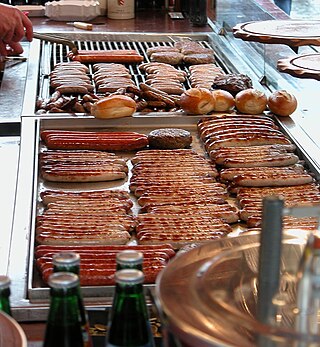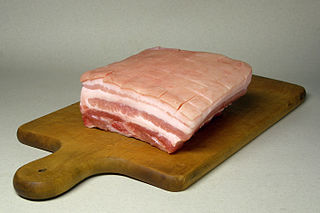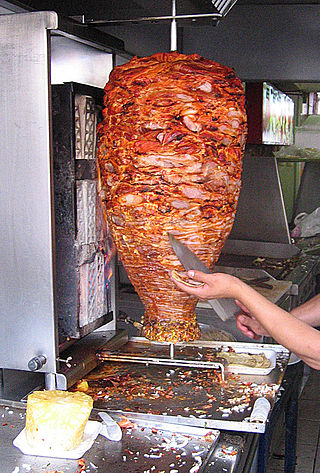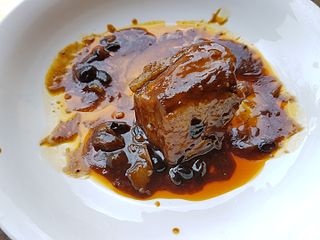
Gazpacho or Gaspacho, also called Andalusian gazpacho, is a cold soup and drink made of raw, blended vegetables. It originated in the southern regions of the Iberian peninsula and spread into other areas. Gazpacho is widely eaten in Spain and Portugal, particularly during hot summers, since it is refreshing and cool.

Bratwurst is a type of German sausage made from pork or, less commonly, beef or veal. The name is derived from the Old High German Brätwurst, from brät-, finely chopped meat, and Wurst, sausage, although in modern German it is often associated with the verb braten, to pan fry or roast. Beef and veal are usually incorporated amongst a blend often including pork.

Green sauce or greensauce is a family of cold, uncooked sauces based on chopped herbs, including the Spanish and Italian salsa verde, the French sauce verte, the German Grüne Soße or Frankfurter Grie Soß, the British mint sauce and greensauce, and the Argentinian chimichurri.
Sweet and sour is a generic term that encompasses many styles of sauce, cuisine and cooking methods. It is commonly used in East Asia and Southeast Asia, and has been used in England since the Middle Ages. Sweet and sour sauce remains popular in Asian and Western cuisines.

Soused herring is raw herring soaked in a mild preserving liquid. It can be raw herring in a mild vinegar pickle or Dutch brined herring. As well as vinegar, the marinade might contain cider, wine or tea, sugar, herbs, spices, and chopped onion.

Pork belly or belly pork is a boneless and fatty cut of meat from the belly of a pig. Pork belly is particularly popular in Hispanic, Chinese, Danish, Norwegian, Korean, Thai and Filipino cuisine.

Arab cuisine is the cuisine of the Arabs, defined as the various regional cuisines spanning the Arab world, from the Maghreb to the Fertile Crescent and the Arabian Peninsula. These cuisines are centuries old and reflect the culture of trading in baharat (spices), herbs, and foods. The regions have many similarities, but also unique traditions. They have also been influenced by climate, cultivation, and mutual commerce.

Al pastor is a preparation of spit-grilled slices of pork originating in the Central Mexican region of Puebla, although today it is a common menu item found in taquerías throughout Mexico. The method of preparing and cooking al pastor is based on the lamb shawarma brought by Lebanese immigrants to the region. Al pastor features a flavor palate that uses traditional Mexican adobada (marinade). It is a popular street food that has spread to the United States. In some places of northern Mexico and coastal Mexico, such as in Baja California, Mexico, taco al pastor is known as taco de trompo or taco de adobada. A similar dish also from Puebla that uses a combination of middle eastern spices and indigenous central Mexican ingredients is called tacos árabes.

Sarapatel, or Sorpotel, is a dish of Portuguese origin now commonly cooked in the coastal Konkan region of India, primarily Goa, Mangalore and East Indians of Mumbai Sarpatel. The former Estado da Índia Portuguesa colony. It is also prepared in northeastern Brazil. The word ‘sarapatel’ literally means confusion, referring to the mish-mash of ingredients which include Pork meat and offal. However, in modern-day version, blood is rarely used as now getting the pure blood is slightly difficult. The meat is first parboiled, then diced and sauteed before being cooked in a spicy and vinegary sauce.

Ajoblanco is a popular Spanish cold soup typical from Granada and Málaga (Andalusia). This dish is made of bread, crushed almonds, garlic, water, olive oil, salt and sometimes vinegar. It is usually served with grapes or slices of melon. When almonds were not available, for instance during the post-war period, flour from dried beans was used.

Persillade is a sauce or seasoning mixture of parsley chopped together with seasonings including garlic, herbs, oil, and vinegar.
Potato cake is a name given to various shaped potato dishes around the world, including a patty of hashed potatoes, a fried patty of mashed potato, a fried and battered slice of potato, or a flatbread made with mashed potato and flour. In some states in Australia a thin slice of potato that is battered and deep fried may be called a potato scallop, potato cake or potato fritter.

Many cuisines feature eggplant salads and appetizers.

Venetian cuisine, from the city of Venice, Italy or more widely from the region of Veneto, has a centuries-long history and differs significantly from other cuisines of northern Italy, and of neighbouring Austria and of Slavic countries, despite sharing some commonalities.

Franconian cuisine is an umbrella term for all dishes with a specific regional identity belonging to the region of Franconia. It is a subtype of German cuisine with many similarities to Bavarian cuisine and Swabian cuisine. It is often included in the Bavarian cuisine, since most parts of Franconia belong to Bavaria today. There are several Franconian food items that are also famous beyond the borders of Franconia, such as Nürnberger Lebkuchen, Bratwurst and the wines of Franconia. Franconia is also famous for its beer and harbours the highest density of breweries in the world.

Swabian cuisine is native to Swabia, a region in southwestern Germany comprising great parts of Württemberg and the Bavarian part of Swabia, as well as the Allgäu which has parts lying in Austria. Swabian cuisine has a reputation for being rustic, but rich and hearty. Fresh egg pastas, soups, and sausages are among Swabia's best-known types of dishes, and Swabian cuisine tends to require broths or sauces; dishes are rarely "dry".

The traditional cuisine of Abruzzo is eclectic, drawing on pastoral, mountain, and coastal cuisine. Staples of Abruzzo cuisine include bread, pasta, meat, fish, cheese, and wine. The isolation which has characterized the region for decades has ensured the independence of its culinary tradition from those of nearby regions. Local cuisine was widely appreciated in a 2013 survey among foreign tourists.

Betawi cuisine is rich, diverse and eclectic, in part because the Betawi people that create them were composed from numbers of regional immigrants that came from various places in the Indonesian archipelago, as well as Chinese, Indian, Arab, and European traders, visitors and immigrants that were attracted to the port city of Batavia since centuries ago.

Humbà, also spelled hombà, is a Filipino braised pork dish originating from the Visayas Islands of the Philippines. It traditionally uses pork belly slow-cooked until very tender in soy sauce, vinegar, black peppercorns, garlic, bay leaves, and fermented black beans (tausi) sweetened with muscovado sugar. It also commonly includes hard-boiled eggs and banana blossoms.
















